-
1
 Whistlejacket
Whistlejacket
Close
Exhibition Square
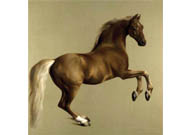 Whistlejacket
George Stubbs
Owned by the Marquess of Rockingham, Whistlejacket was one of the most celebrated racehorses of the day. Legend has it that George III was to ride the horse in the painting, but Rockingham changed his mind when they had political differences. George Stubbs was a stickler for accuracy. He studied anatomy and dissected horses to get them absolutely right. It worked; allegedly Whistlejacket caught a glimpse of his likeness, and tried to attack the canvas.
Whistlejacket
George Stubbs
Owned by the Marquess of Rockingham, Whistlejacket was one of the most celebrated racehorses of the day. Legend has it that George III was to ride the horse in the painting, but Rockingham changed his mind when they had political differences. George Stubbs was a stickler for accuracy. He studied anatomy and dissected horses to get them absolutely right. It worked; allegedly Whistlejacket caught a glimpse of his likeness, and tried to attack the canvas.
Click here to find out more
-
2
 Christina of Denmark
Christina of Denmark
Close
York Pullman Bus, Bootham Tower
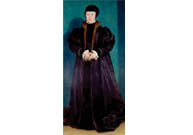 Christina of Denmark,
Christina of Denmark,
Duchess of Milan
Hans Holbein the Younger
Holbein's picture of the demure widow Christina of Denmark was a lonely-hearts ad for Henry VIII, who was looking for a fourth wife after Jane Seymour's death. Christina was sixteen at the time and a renowned beauty. Apparently the kind fell madly in love with her on the strength of this portrait, an infatuation shared with generations of viewers. Fortunately the marriage never was and she lived into old age.
Click here to find out more
-
3
 The Rokeby Venus
The Rokeby Venus
Close
Bootham Bar
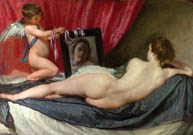 The Rokeby Venus
Diego Velázquez
Venus, the Goddess of Love, was regarded as a personification of female beauty. She is shown here with her son Cupid, who holds up a mirror for her to look both at herself and at the viewer. This rare Spanish nude was in the collection of the Marqués del Carpio, son of the First Minister of Spain and was presumably displayed privately, thus avoiding the censure of the Spanish Inquisition.
The Rokeby Venus
Diego Velázquez
Venus, the Goddess of Love, was regarded as a personification of female beauty. She is shown here with her son Cupid, who holds up a mirror for her to look both at herself and at the viewer. This rare Spanish nude was in the collection of the Marqués del Carpio, son of the First Minister of Spain and was presumably displayed privately, thus avoiding the censure of the Spanish Inquisition.
Click here to find out more
-
4
 The Ambassadors
The Ambassadors
Close
Bootham Bar
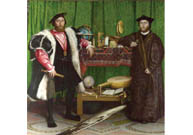 The Ambassadors
Hans Holbein the Younger
This portrait shows two self-satisfied young men. In the pink shirt is Jean de Dinteville, French ambassador to England in 1533. His friend is Georges de Selve, the Bishop of Lavaur. They are surrounded by objects symbolising their education and interests.
The Ambassadors
Hans Holbein the Younger
This portrait shows two self-satisfied young men. In the pink shirt is Jean de Dinteville, French ambassador to England in 1533. His friend is Georges de Selve, the Bishop of Lavaur. They are surrounded by objects symbolising their education and interests.
Click here to find out more
-
5
 A Scene from 'The…
A Scene from 'The…
Close
York Theatre Royal
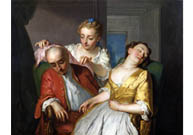 A Scene from 'The Careless Husband'
Philip Mercier
This painting was created in 1738 by Philip Mercier, a French-born artist and formally an art dealer, who settled in England and became patronised by Frederick, Prince of Wales. The Careless Husband was a popular comedy by Colley Cibber, a playwright and Poet Laureate, written in 1704.
A Scene from 'The Careless Husband'
Philip Mercier
This painting was created in 1738 by Philip Mercier, a French-born artist and formally an art dealer, who settled in England and became patronised by Frederick, Prince of Wales. The Careless Husband was a popular comedy by Colley Cibber, a playwright and Poet Laureate, written in 1704.
-
6
 Three Men and a Boy
Three Men and a Boy
Close
The Lodge, Museum Gardens
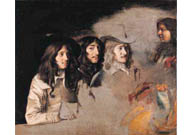 Three Men and a Boy
Le Nain brothers
Sometimes, it's hard to tell brothers apart. Never more so than Antoine, Louis and Mathieu Le Nain, who were celebrated artists in Paris in the 1620s. Whether working individually or collaborating, their paintings were signed simply 'Le Nain'. Three Men and a Boy might be a self-portrait of the siblings, though which is which remains a mystery. The young boy's head emerged under many layers of paint during cleaning in 1968.
Three Men and a Boy
Le Nain brothers
Sometimes, it's hard to tell brothers apart. Never more so than Antoine, Louis and Mathieu Le Nain, who were celebrated artists in Paris in the 1620s. Whether working individually or collaborating, their paintings were signed simply 'Le Nain'. Three Men and a Boy might be a self-portrait of the siblings, though which is which remains a mystery. The young boy's head emerged under many layers of paint during cleaning in 1968.
Click here to find out more
-
7
 An Experiment…
An Experiment…
Close
The Observatory, Museum Gardens
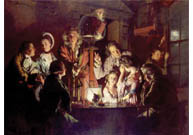 An Experiment on a Bird in the Air Pump
Joseph Wright of Derby
Joseph Wright hailed from Derby, a town at the centre of the industrial revolution. This painting shows a dramatic experiment. A rare, white cockatoo is held in a flask from which the air is being removed. Unless it gets oxygen soon, it will die. The reactions around the table are minutely observed; only the distracted lovers remain unmoved.
An Experiment on a Bird in the Air Pump
Joseph Wright of Derby
Joseph Wright hailed from Derby, a town at the centre of the industrial revolution. This painting shows a dramatic experiment. A rare, white cockatoo is held in a flask from which the air is being removed. Unless it gets oxygen soon, it will die. The reactions around the table are minutely observed; only the distracted lovers remain unmoved.
Click here to find out more
-
8
 Bacchus and Ariadne
Bacchus and Ariadne
Close
Yorkshire Museum
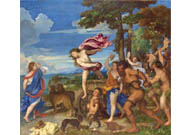 Bacchus and Ariadne
Titian
Bacchus, God of Wine, emerges from a night out with his crew. He sees Ariadne and falls in love. Ariadne has just been deserted by Theseus after helping defeat the Minotaur (his ship is sailing into the distance). Bacchus elevates her to heaven and turns her into a constellation, represented by the stars above her head. Titian unfolds all the drama in his trademark, blazing colour.
Bacchus and Ariadne
Titian
Bacchus, God of Wine, emerges from a night out with his crew. He sees Ariadne and falls in love. Ariadne has just been deserted by Theseus after helping defeat the Minotaur (his ship is sailing into the distance). Bacchus elevates her to heaven and turns her into a constellation, represented by the stars above her head. Titian unfolds all the drama in his trademark, blazing colour.
Click here to find out more
-
9
 Salome receives…
Salome receives…
Close
Abbey Church Ruins
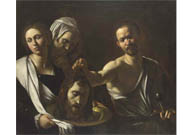 Salome receives the head of Saint John the Baptist
Michelangelo Merisi da Caravaggio
Painted in Naples not long before Caravaggio's death, this painting depicts the gruesome new testament story of Salome, who danced so entrancingly that king Herod swore he would give her anything. Egged on by her vengeful mother, she asked for the head of John the Baptist on a plate. The pathos and human tragedy of the tale are delivered with exceptional economy and brutal raw power.
Salome receives the head of Saint John the Baptist
Michelangelo Merisi da Caravaggio
Painted in Naples not long before Caravaggio's death, this painting depicts the gruesome new testament story of Salome, who danced so entrancingly that king Herod swore he would give her anything. Egged on by her vengeful mother, she asked for the head of John the Baptist on a plate. The pathos and human tragedy of the tale are delivered with exceptional economy and brutal raw power.
Click here to find out more
-
10
 The Triumph…
The Triumph…
Close
Abbey Church Ruins
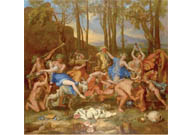 The Triumph of Pan
Nicolas Poussin
The Triumph of Pan shows a wild, Pagan celebration in full swing. It's packed with literary and visual references, demonstrating not only Poussin's mastery of painting but also his deep, classical scholarship. The work belonged to Cardinal Richelieu, and was housed in an extravagant room dripping with fine art and gilt décor.
The Triumph of Pan
Nicolas Poussin
The Triumph of Pan shows a wild, Pagan celebration in full swing. It's packed with literary and visual references, demonstrating not only Poussin's mastery of painting but also his deep, classical scholarship. The work belonged to Cardinal Richelieu, and was housed in an extravagant room dripping with fine art and gilt décor.
Click here to find out more
-
11
 The Arnolfini…
The Arnolfini…
Close
The Hospitium, Museum Gardens
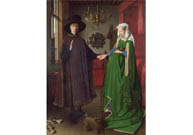 The Arnolfini Portrait
Jan van Eyck
Van Eyck used oil paints in a dramatic new way, pushing the medium to its limits and achieving all kinds of textures and effects. His double portrait of the wealthy merchant Giovanni di Nicolao Arnolfini and wife isn't as was once thought a wedding portrait. Nor is she pregnant, it's just the fashion of the time. Anticipating modern graffiti, the ornate Latin signature over the mirror reads 'Jan van Eyck was here 1434'.
The Arnolfini Portrait
Jan van Eyck
Van Eyck used oil paints in a dramatic new way, pushing the medium to its limits and achieving all kinds of textures and effects. His double portrait of the wealthy merchant Giovanni di Nicolao Arnolfini and wife isn't as was once thought a wedding portrait. Nor is she pregnant, it's just the fashion of the time. Anticipating modern graffiti, the ornate Latin signature over the mirror reads 'Jan van Eyck was here 1434'.
Click here to find out more
-
12
 Seaport with the…
Seaport with the…
Close
The Hospitium, Museum Gardens
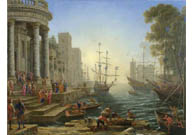 Seaport with the Embarkation of Saint Ursula
Claude Lorrain
It's thought that Claude emigrated to Rome as a boy. His reinventions of a golden age profoundly influenced landscape painting, and painting itself, particularly in 18th Century England. According to legend, Saint Ursula (a British princess) made a pilgrimage to Rome, with eleven thousand virgins. On their return, pagan huns slaughtered them when Ursula refused to marry their Chieftain. This picture shows her in happier times, radiant in the golden morning sun.
Seaport with the Embarkation of Saint Ursula
Claude Lorrain
It's thought that Claude emigrated to Rome as a boy. His reinventions of a golden age profoundly influenced landscape painting, and painting itself, particularly in 18th Century England. According to legend, Saint Ursula (a British princess) made a pilgrimage to Rome, with eleven thousand virgins. On their return, pagan huns slaughtered them when Ursula refused to marry their Chieftain. This picture shows her in happier times, radiant in the golden morning sun.
Click here to find out more
-
13
 The Skiff
The Skiff
Close
Water Tower,
Dame Judi Dench Walk
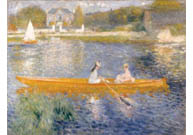 The Skiff
Pierre-Auguste Renoir
The Skiff is an impressionist vision of suburban leisure, as two young women enjoy a lazy Summer's day on the river. The dazzling blue of the water and the bright chrome orange of the boat also provided an opportunity for Renoir to test impressionist colour theory. They are opposites on the colour scale and create an intense contrast when put together.
The Skiff
Pierre-Auguste Renoir
The Skiff is an impressionist vision of suburban leisure, as two young women enjoy a lazy Summer's day on the river. The dazzling blue of the water and the bright chrome orange of the boat also provided an opportunity for Renoir to test impressionist colour theory. They are opposites on the colour scale and create an intense contrast when put together.
Click here to find out more
-
14
 Bathers at La…
Bathers at La…
Close
Water Tower,
Dame Judi Dench Walk
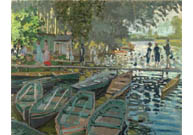 Bathers at La Grenouillère
Claude-Oscar Monet
In the Summer of 1869, Monet worked alongside Renoir at La Grenouill, a rather risqué bohemian resort on the Seine just outside Paris. Fresh, direct and experimental, Bathers at La Genouillere became one of impressionism's most famous pictures. But it was only a quick sketch for a more ambitious composition (now lost), to be painted back in the studio. The distinctive style couldn't have been achieved without recent innovations in artists' materials - portable tubes in oil paint and flat brushes.
Bathers at La Grenouillère
Claude-Oscar Monet
In the Summer of 1869, Monet worked alongside Renoir at La Grenouill, a rather risqué bohemian resort on the Seine just outside Paris. Fresh, direct and experimental, Bathers at La Genouillere became one of impressionism's most famous pictures. But it was only a quick sketch for a more ambitious composition (now lost), to be painted back in the studio. The distinctive style couldn't have been achieved without recent innovations in artists' materials - portable tubes in oil paint and flat brushes.
Click here to find out more
-
15
 A Young Woman…
A Young Woman…
Close
Nailed on Beauty, 11 Lendal
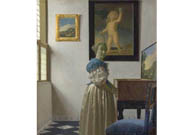 A Young Woman Standing at a Virginal
Johannes Vermeer
Only around 30 paintings by Vermeer are known today, because he worked very slowly, ran an inn and an art dealership, and died aged 43. This interior bears all the hallmarks of his paintings. The arrangement is fastidious, a finely balanced geometry containing beautifully worked details. The woman, looking expectantly in our direction, plays music reminding her of an absent man, signified by the empty chair. The painting of Cupid holding up a single playing card symbolises fidelity.
A Young Woman Standing at a Virginal
Johannes Vermeer
Only around 30 paintings by Vermeer are known today, because he worked very slowly, ran an inn and an art dealership, and died aged 43. This interior bears all the hallmarks of his paintings. The arrangement is fastidious, a finely balanced geometry containing beautifully worked details. The woman, looking expectantly in our direction, plays music reminding her of an absent man, signified by the empty chair. The painting of Cupid holding up a single playing card symbolises fidelity.
Click here to find out more
-
16
 The Doge Leonardo…
The Doge Leonardo…
Close
The Guildhall
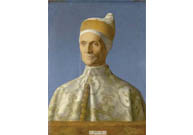 The Doge Leonardo Loredan
Giovanni Bellini
Bellini hailed from the leading artistic dynasty of 15th Century Venice, following his father and brother with this official state commission Doge Leonardo Loredan was top dog in the Venetian republic, shown here in full regalia. Bellini tells us about him subtly: the shadowed side of the face is gentler-looking than the starker left side, and the setting sun is reflected in his eyes - perhaps a comment on the doge's advancing years.
The Doge Leonardo Loredan
Giovanni Bellini
Bellini hailed from the leading artistic dynasty of 15th Century Venice, following his father and brother with this official state commission Doge Leonardo Loredan was top dog in the Venetian republic, shown here in full regalia. Bellini tells us about him subtly: the shadowed side of the face is gentler-looking than the starker left side, and the setting sun is reflected in his eyes - perhaps a comment on the doge's advancing years.
Click here to find out more
-
17
 Venus and Mars
Venus and Mars
Close
City Screen, Coney Street
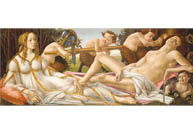 Venus and Mars
Sandro Botticelli
Botticelli is famed for his religious paintings. Venus and Mars, however, is earthy, packed with sexual innuendo, and was probably a piece of bedroom furniture. Venus, Goddess of Love, has conquered Mars, God of War, with her over-whelming beauty. Clearly exhausted, a post-coital Mars sleeps with Venus looking on. Meanwhile, mischievous satyrs make off with his lance and helmet, both phallic symbols, suggesting a 'Make Love not War' message.
Venus and Mars
Sandro Botticelli
Botticelli is famed for his religious paintings. Venus and Mars, however, is earthy, packed with sexual innuendo, and was probably a piece of bedroom furniture. Venus, Goddess of Love, has conquered Mars, God of War, with her over-whelming beauty. Clearly exhausted, a post-coital Mars sleeps with Venus looking on. Meanwhile, mischievous satyrs make off with his lance and helmet, both phallic symbols, suggesting a 'Make Love not War' message.
Click here to find out more
-
18
 The Entombment
The Entombment
Close
St Helen's Graveyard, Davygate
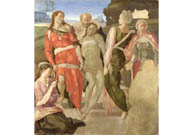 The Entombment
Michelangelo
This early work by Michelangelo, the original Renaissance man, was intended as an altarpiece, but was never finished. Christ, in the centre, is supported by John the Evangelist, Joseph of Arimathea and Nicodemus. Mary Magdelene and Mary Salome (a holy woman) are also shown. The empty outline on the right is reserved for the Virgin Mary Michelangelo may have been waiting for rare and costly ultramarine pigment for her traditional blue cloak.
The Entombment
Michelangelo
This early work by Michelangelo, the original Renaissance man, was intended as an altarpiece, but was never finished. Christ, in the centre, is supported by John the Evangelist, Joseph of Arimathea and Nicodemus. Mary Magdelene and Mary Salome (a holy woman) are also shown. The empty outline on the right is reserved for the Virgin Mary Michelangelo may have been waiting for rare and costly ultramarine pigment for her traditional blue cloak.
Click here to find out more
-
19
 Lady Cockburn…
Lady Cockburn…
Close
St Helen's Graveyard, Davygate
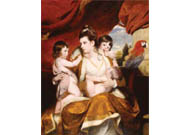 Lady Cockburn and her Three Eldest Sons
Sir Joshua Reynolds
Son of a village schoolmaster, Joshua Reynolds rose to become the most sought-after portrait painter of his age, a founder of the Royal Academy, and friend to the most eminent men of letters in England. Reynolds idealised his subjects, portraying them in a classical context. Here, Lady Cockburn is cast as charity, who is traditionally shown with three children. James, on the left, is based on Cupid, as seen in the Rokeby Venus by Veluez.
Lady Cockburn and her Three Eldest Sons
Sir Joshua Reynolds
Son of a village schoolmaster, Joshua Reynolds rose to become the most sought-after portrait painter of his age, a founder of the Royal Academy, and friend to the most eminent men of letters in England. Reynolds idealised his subjects, portraying them in a classical context. Here, Lady Cockburn is cast as charity, who is traditionally shown with three children. James, on the left, is based on Cupid, as seen in the Rokeby Venus by Veluez.
Click here to find out more
-
20
 Sunflowers
Sunflowers
Close
St Helen's Church, St Helen's Square
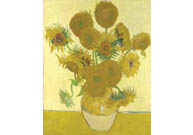 Sunflowers
Vincent Van Gogh
Van Gogh painted a series of sunflowers anticipating the arrival of his friend, the poet-artist Paul Gauguin, to his house in Arles, France in 1888. The painting is strikingly yellow, using newly invented pigments that made vibrant colours possible. Ironically, yellow symbolised happiness for Van Gogh, because it was the heated rows he had while working with Gaughin that finally tipped him into despair and madness.
Sunflowers
Vincent Van Gogh
Van Gogh painted a series of sunflowers anticipating the arrival of his friend, the poet-artist Paul Gauguin, to his house in Arles, France in 1888. The painting is strikingly yellow, using newly invented pigments that made vibrant colours possible. Ironically, yellow symbolised happiness for Van Gogh, because it was the heated rows he had while working with Gaughin that finally tipped him into despair and madness.
Click here to find out more
-
21
 The Supper at Emmaus
The Supper at Emmaus
Close
Dean Court Hotel, High Petergate
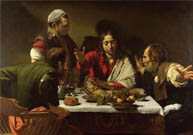 The Supper at Emmaus
Michelangelo Merisi da Caravaggio
Some see in Caragaggio's paintings a reflection of his character. A volatile visionary, Caravaggio swaggered through the streets of Rome with a sword at his side. The supper at Emmaus depicts Christ's appearance to his disciples after the resurrection. Their outstretched arms draw us into the painting, including us in the event. It still has the power to dazzle to this day. As Holbein immortalizes them in art, he reminds us that we all die. Stand to the right of the painting, you should see a skull, between the ambassadors, signifying the brevity of life.
The Supper at Emmaus
Michelangelo Merisi da Caravaggio
Some see in Caragaggio's paintings a reflection of his character. A volatile visionary, Caravaggio swaggered through the streets of Rome with a sword at his side. The supper at Emmaus depicts Christ's appearance to his disciples after the resurrection. Their outstretched arms draw us into the painting, including us in the event. It still has the power to dazzle to this day. As Holbein immortalizes them in art, he reminds us that we all die. Stand to the right of the painting, you should see a skull, between the ambassadors, signifying the brevity of life.
-
22
 Surprised! (Tiger in…
Surprised! (Tiger in…
Close
36 High Petergate
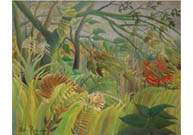 Surprised! (Tiger in a Tropical Storm)
Henri Rousseau
Never one to play by the rules, Rousseau discovered art in his forties, after careers as a regimental bandsman and toll collector. He claimed his stylised, highly patterned jungle paintings were informed by first-hand experience with the French army in Mexico, but they were more likely inspired by prints, visits to the local botanical gardens and humble house plants. When he exhibited this dreamlike canvas in 1891, Rousseau called it 'surpris!' suggesting explorers outside the picture frame about to be pounced on by the tiger.
Surprised! (Tiger in a Tropical Storm)
Henri Rousseau
Never one to play by the rules, Rousseau discovered art in his forties, after careers as a regimental bandsman and toll collector. He claimed his stylised, highly patterned jungle paintings were informed by first-hand experience with the French army in Mexico, but they were more likely inspired by prints, visits to the local botanical gardens and humble house plants. When he exhibited this dreamlike canvas in 1891, Rousseau called it 'surpris!' suggesting explorers outside the picture frame about to be pounced on by the tiger.
Click here to find out more
-
23
 A Wheatfield…
A Wheatfield…
Close
St Michael le Belfrey
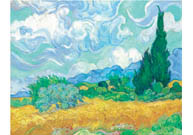 A Wheatfield, with Cypresses
Vincent Van Gogh
After his breakdown and self-mutilation, Vincent Van Gogh checked into the St-R asylum, near Arles. He completed around 150 canvasses in the asylum that year. Among them were three versions of the turbulent, swirling Wheatfield with Cypresses. The blazing yellow wheat field represents the life cycle and creative force. The tall, dark cypress tree native to Provence is associated with death. Soon after leaving St-R, Van Gogh shot himself in a wheat field. He died two days later.
A Wheatfield, with Cypresses
Vincent Van Gogh
After his breakdown and self-mutilation, Vincent Van Gogh checked into the St-R asylum, near Arles. He completed around 150 canvasses in the asylum that year. Among them were three versions of the turbulent, swirling Wheatfield with Cypresses. The blazing yellow wheat field represents the life cycle and creative force. The tall, dark cypress tree native to Provence is associated with death. Soon after leaving St-R, Van Gogh shot himself in a wheat field. He died two days later.
Click here to find out more
-
24
 Self Portrait at the…
Self Portrait at the…
Close
Shared Earth, Petergate
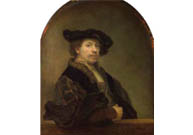 Self Portrait at the Age of 34
Rembrandt
One of Rembrandt's favourite subjects was himself; he painted between 50 and 60 self-portraits. Here, Rembrandt is at his peak. He's dressed in exotic and expensive garments - the 17th Century equivalent of bling. His pose mimics Titan's Man with a quilted sleeve inviting direct comparison with this Italian master.
Self Portrait at the Age of 34
Rembrandt
One of Rembrandt's favourite subjects was himself; he painted between 50 and 60 self-portraits. Here, Rembrandt is at his peak. He's dressed in exotic and expensive garments - the 17th Century equivalent of bling. His pose mimics Titan's Man with a quilted sleeve inviting direct comparison with this Italian master.
Click here to find out more
-
25
 Corner of a Café…
Corner of a Café…
Close
Snickleway, Stonegate to Grape Lane
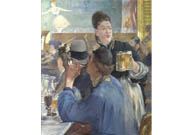 Corner of a Café-Concert
Edouard Manet
Manet's paintings caused a stir, making him a hero to the emerging impressionists who were looking to shake up the status quo. Corner of a café-concert is the right half of a painting, enlarged and with new background added. It captures one of Manet's favourite watering holes, the brasserie Reichshoffen on the Boulevard Rochechouart. Manet's observations of 19th Century life are fluid and rough-edged, capturing a real sense of Parisian life.
Corner of a Café-Concert
Edouard Manet
Manet's paintings caused a stir, making him a hero to the emerging impressionists who were looking to shake up the status quo. Corner of a café-concert is the right half of a painting, enlarged and with new background added. It captures one of Manet's favourite watering holes, the brasserie Reichshoffen on the Boulevard Rochechouart. Manet's observations of 19th Century life are fluid and rough-edged, capturing a real sense of Parisian life.
Click here to find out more
-
26
 Allegory with…
Allegory with…
Close
Coffee Yard
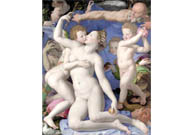 Allegory with Venus and Cupid
Bronzino
Bronzino was the ultra-fashionable court painter to the Medici family. Duke Cosimo was responsible for commissioning this complex allegory as a carefully considered present for the King of France, a man with a notorious lust for flesh. Packed with riddles and symbolism, it would have given him plenty of excuse to ogle the sensual bodies of the cavorting Venus and Cupid, while decoding its finer meaning.
Allegory with Venus and Cupid
Bronzino
Bronzino was the ultra-fashionable court painter to the Medici family. Duke Cosimo was responsible for commissioning this complex allegory as a carefully considered present for the King of France, a man with a notorious lust for flesh. Packed with riddles and symbolism, it would have given him plenty of excuse to ogle the sensual bodies of the cavorting Venus and Cupid, while decoding its finer meaning.
Click here to find out more
-
27
 A Grotesque…
A Grotesque…
Close
Coffee Yard
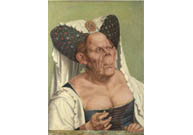 A Grotesque Old Woman
Bronzino
Massys was a cultural magpie. A leading painter in Antwerp by 1510, he drew inspiration from local Flemish artists, among others. It's possible that the inspiration for this painting came from the faces drawn in Leonardo's notebooks. The painting is thought to be a satire on vain old women dressing too youthfully. She became the inspiration to John Tenniel, illustrator of Alice in Wonderland, for his ugly duchess.
A Grotesque Old Woman
Bronzino
Massys was a cultural magpie. A leading painter in Antwerp by 1510, he drew inspiration from local Flemish artists, among others. It's possible that the inspiration for this painting came from the faces drawn in Leonardo's notebooks. The painting is thought to be a satire on vain old women dressing too youthfully. She became the inspiration to John Tenniel, illustrator of Alice in Wonderland, for his ugly duchess.
Click here to find out more
-
28
 Samson and Delilah
Samson and Delilah
Close
St Sampson's Church (Annexe)
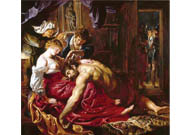 Samson and Delilah
Peter Paul Rubens
Like a still from a film, Rubens' painting of Delilah and Samson freeze-frames the drama of one moment in time. It's a retelling of the powerful Old Testament story, where the mighty Jewish hero falls for a prostitute, and reveals that the secret of his strength lies in his uncut locks. Having exhausted him after a night of passion, Delilah cuts his hair, and hands him over emasculated to his enemies, the Philistines.
Samson and Delilah
Peter Paul Rubens
Like a still from a film, Rubens' painting of Delilah and Samson freeze-frames the drama of one moment in time. It's a retelling of the powerful Old Testament story, where the mighty Jewish hero falls for a prostitute, and reveals that the secret of his strength lies in his uncut locks. Having exhausted him after a night of passion, Delilah cuts his hair, and hands him over emasculated to his enemies, the Philistines.
Click here to find out more
-
29
 The Four Elements…
The Four Elements…
Close
4 Jubbergate
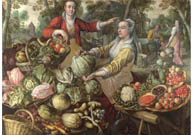 The Four Elements: Earth
Joachim Beuckelaer
Beuckelaer was a still life pioneer. At first glance, this picture appears to be of a common food market. If you look at the top left-hand corner, however, the holy family can be made out crossing a bridge, adding a religious message to the scene. A warning against earthly gratification, the over-abundance of fruit and vegetables in the foreground is painted with tempting sensuality. There are 16 different types of produce shown, tumbling out of the painting towards the viewer.
The Four Elements: Earth
Joachim Beuckelaer
Beuckelaer was a still life pioneer. At first glance, this picture appears to be of a common food market. If you look at the top left-hand corner, however, the holy family can be made out crossing a bridge, adding a religious message to the scene. A warning against earthly gratification, the over-abundance of fruit and vegetables in the foreground is painted with tempting sensuality. There are 16 different types of produce shown, tumbling out of the painting towards the viewer.
Click here to find out more
-
30
 An Extensive…
An Extensive…
Close
Newgate, The Shambles
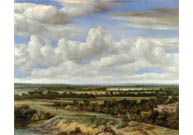 An Extensive Landscape with a Road by a River
Philips Koninck
Koninck may have been a pupil of Rembrandt's. His sweeping, low-skied, panoramic views are part of the tradition of Dutch landscape art. This landscape could be real, or conjured from Koninck's imagination. Varied application of the paint suggests depth; rough at the front, detailed in the middle, with bold strokes of colour in the distance. Koninck often asked a fellow artist to place figures into the landscape for him, but seems to have painted these himself.
An Extensive Landscape with a Road by a River
Philips Koninck
Koninck may have been a pupil of Rembrandt's. His sweeping, low-skied, panoramic views are part of the tradition of Dutch landscape art. This landscape could be real, or conjured from Koninck's imagination. Varied application of the paint suggests depth; rough at the front, detailed in the middle, with bold strokes of colour in the distance. Koninck often asked a fellow artist to place figures into the landscape for him, but seems to have painted these himself.
Click here to find out more
-
31
 Philip IV of Spain…
Philip IV of Spain…
Close
St Crux, The Shambles
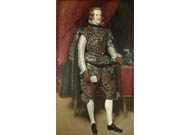 Philip IV of Spain in Brown and Silver
Diego Velázquez
Veluez became a court painter when he was 24 and Philip IV was just 18. When Veluez left Madrid to study in Italy, Philip refused to be portrayed by anyone else. This portrait was painted soon after Veluez's return in 1631. The pose is confident, but there's timidity in Philip's eyes. Freely brushed blobs and strokes over the costume give an impression of glinting silver embroidery over rich cloth.
Philip IV of Spain in Brown and Silver
Diego Velázquez
Veluez became a court painter when he was 24 and Philip IV was just 18. When Veluez left Madrid to study in Italy, Philip refused to be portrayed by anyone else. This portrait was painted soon after Veluez's return in 1631. The pose is confident, but there's timidity in Philip's eyes. Freely brushed blobs and strokes over the costume give an impression of glinting silver embroidery over rich cloth.
-
32
 Saint Michael…
Saint Michael…
Close
Marks and Spencer, The Shambles
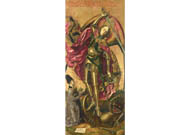 Saint Michael Triumphant over the Devil
Bartolomé Bermejo
Bartolomermejo was a loud, proud 15th Century redhead, signing his pictures Bartolomeus Ruebus ('Red Bartholomew'). Antonio Juan, the feudal Lord of Tous, near Valencia, commissioned this painting as an altarpiece. He's on the left watching as St Michael triumphs over a devil that, although taken from the Book of Revelations, is a creature from Bermeio's imagination.
Saint Michael Triumphant over the Devil
Bartolomé Bermejo
Bartolomermejo was a loud, proud 15th Century redhead, signing his pictures Bartolomeus Ruebus ('Red Bartholomew'). Antonio Juan, the feudal Lord of Tous, near Valencia, commissioned this painting as an altarpiece. He's on the left watching as St Michael triumphs over a devil that, although taken from the Book of Revelations, is a creature from Bermeio's imagination.
-
33
 Madame Moitessier
Madame Moitessier
Close
Lady Peckett’s Yard, Fossgate
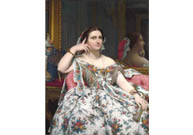 Madame Moitessier
Jean-Auguste-Dominique Ingres
Ingres' opulent portrait of Madame Moitessier very nearly never happened. Approached by her rich banker husband in 1847, Ingres refused to take on the commission. But once he'd seen the fragrant Inès he was smitten and changed his mind. Even then, it took him 12 years to complete, by which time he was 76. The pose is inspired by an ancient Roman wall painting of a goddess, suggesting Ingres saw her as an ideal of classical beauty.
Madame Moitessier
Jean-Auguste-Dominique Ingres
Ingres' opulent portrait of Madame Moitessier very nearly never happened. Approached by her rich banker husband in 1847, Ingres refused to take on the commission. But once he'd seen the fragrant Inès he was smitten and changed his mind. Even then, it took him 12 years to complete, by which time he was 76. The pose is inspired by an ancient Roman wall painting of a goddess, suggesting Ingres saw her as an ideal of classical beauty.
-
34
 Belshazzar's Feast
Belshazzar's Feast
Close
All Saints, Pavement
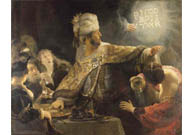 Belshazzar's Feast
Rembrandt
Rembrandt wanted to be a religious painter but in the strictly Calvinist Dutch republic the adornment of churches was forbidden, so he recreated bible scenes for private clients instead. This painting tells the story of the king of Babylon, who gave a feast for his nobles using sacred vessels looted from the temple in Jerusalem. A divine hand appeared, carving an inscription foretelling the ruin of Belshazzar's kingdom. Framed and lit like a movie still, Rembrandt skillfully captures the dread and horror of the guests.
Belshazzar's Feast
Rembrandt
Rembrandt wanted to be a religious painter but in the strictly Calvinist Dutch republic the adornment of churches was forbidden, so he recreated bible scenes for private clients instead. This painting tells the story of the king of Babylon, who gave a feast for his nobles using sacred vessels looted from the temple in Jerusalem. A divine hand appeared, carving an inscription foretelling the ruin of Belshazzar's kingdom. Framed and lit like a movie still, Rembrandt skillfully captures the dread and horror of the guests.
-
35
 Four Officers of the…
Four Officers of the…
Close
Merchant Adventurers' Hall
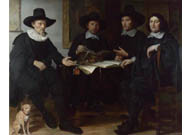 Four Officers of the Amsterdam Coopers' and Wine-rackers' Guild
Gerbrand van den Eeckhout
Eeckhout was one of Rembrandt's favourite pupils. Though he had his master's style off to a tee, he wasn't as daringly original. The painting is typical of group portraits of the age, depicting prosperous, businessmen in the equivalent of a team photo. This particular guild included the men who made barrels for the wine imported into Amsterdam, and others who sampled and bottled it. One of the gents pictured is Eeckhout's brother.
Four Officers of the Amsterdam Coopers' and Wine-rackers' Guild
Gerbrand van den Eeckhout
Eeckhout was one of Rembrandt's favourite pupils. Though he had his master's style off to a tee, he wasn't as daringly original. The painting is typical of group portraits of the age, depicting prosperous, businessmen in the equivalent of a team photo. This particular guild included the men who made barrels for the wine imported into Amsterdam, and others who sampled and bottled it. One of the gents pictured is Eeckhout's brother.
-
36
 The Hay Wain
The Hay Wain
Close
Coppergate Centre
(riverside walk)
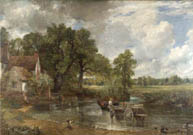 The Hay Wain
John Constable
Now one of the nation's best-loved paintings, when Constable first exhibited the Hay Wain in the early 1820s, he didn't get a sniff of a sale. He had to take it to France to find a buyer. The setting is the River Stour near Flatford in Suffolk, which remains remarkably unspoiled today. the rustic cart (or hay wain) is soaking its wooden wheels to stop them cracking on a long, hot journey.
The Hay Wain
John Constable
Now one of the nation's best-loved paintings, when Constable first exhibited the Hay Wain in the early 1820s, he didn't get a sniff of a sale. He had to take it to France to find a buyer. The setting is the River Stour near Flatford in Suffolk, which remains remarkably unspoiled today. the rustic cart (or hay wain) is soaking its wooden wheels to stop them cracking on a long, hot journey.
-
37
 The Water-Lily Pond
The Water-Lily Pond
Close
Coppergate Centre
(riverside walk)
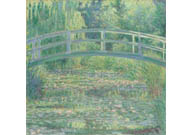 The Water-Lily Pond
Claude-Oscar Monet
The impressionists were obsessed with all things Japanese. Once he became rich, Monet painstakingly cultivated an oriental water garden, complete with simple arching bridge, on his estate at Giverney in rural France. Then he painted it at least 18 times, at various times of the day, all from the same perspective. They are a triumph of vision and technique, seemingly disjointed fragments coming together to form a shimmering whole.
The Water-Lily Pond
Claude-Oscar Monet
The impressionists were obsessed with all things Japanese. Once he became rich, Monet painstakingly cultivated an oriental water garden, complete with simple arching bridge, on his estate at Giverney in rural France. Then he painted it at least 18 times, at various times of the day, all from the same perspective. They are a triumph of vision and technique, seemingly disjointed fragments coming together to form a shimmering whole.
-
38
 After the Bath…
After the Bath…
Close
Fenwicks, Coppergate Centre
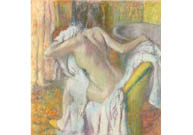 After the Bath, Woman drying herself
Hilaire-Germain-Edgar Degas
In later life, eye trouble forced Degas to stick to indoor subjects. He favoured bright pastels, partly because they produced vivid, modern colours, but he could also see them more easily. The woman pictured is going about an intimate everyday act, seemingly unaware of the viewer. Degas seems to have extended his composition while working on it, adding pieces of paper. He's exploited the flexibility of pastels to create sumptuous textures and blurred contours suggesting movement.
After the Bath, Woman drying herself
Hilaire-Germain-Edgar Degas
In later life, eye trouble forced Degas to stick to indoor subjects. He favoured bright pastels, partly because they produced vivid, modern colours, but he could also see them more easily. The woman pictured is going about an intimate everyday act, seemingly unaware of the viewer. Degas seems to have extended his composition while working on it, adding pieces of paper. He's exploited the flexibility of pastels to create sumptuous textures and blurred contours suggesting movement.
-
39
 Mr and Mrs Andrews
Mr and Mrs Andrews
Close
Fairfax House, Coppergate Centre
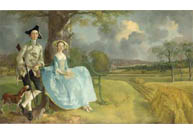 Mr and Mrs Andrews
Thomas Gainsborough
This portrait is a masterpiece from Gainsborough's early years, painted soon after the marriage of Robert Andrews to his wife Frances Mary. The portrait in an open-air setting is typical of Gainsborough's early works. Mr Andrews' satisfaction with his farmlands pales in comparison to the passion with which Gainsborough paints the gold and green fields beyond, allowing him to display his skills as a painter of changing weather and glorious scenery.
Mr and Mrs Andrews
Thomas Gainsborough
This portrait is a masterpiece from Gainsborough's early years, painted soon after the marriage of Robert Andrews to his wife Frances Mary. The portrait in an open-air setting is typical of Gainsborough's early works. Mr Andrews' satisfaction with his farmlands pales in comparison to the passion with which Gainsborough paints the gold and green fields beyond, allowing him to display his skills as a painter of changing weather and glorious scenery.
-
40
 The Virgin of the Rocks
The Virgin of the Rocks
Close
York St Mary's
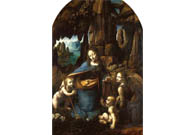 The Virgin of the Rocks
Leonardo da Vinci
The Virgin of the Rocks is typical of Leonardo's brilliant, yet mysterious paintings. The scene shows the Virgin Mary, the Christ child, John the Baptist as a baby, and an angel in a cavernous, watery landscape. Commissioned as an altarpiece, it is one of two versions. The other hangs in the Louvre and was recently featured in the Da Vinci Code.
The Virgin of the Rocks
Leonardo da Vinci
The Virgin of the Rocks is typical of Leonardo's brilliant, yet mysterious paintings. The scene shows the Virgin Mary, the Christ child, John the Baptist as a baby, and an angel in a cavernous, watery landscape. Commissioned as an altarpiece, it is one of two versions. The other hangs in the Louvre and was recently featured in the Da Vinci Code.
-
41
 Portrait of Jean…
Portrait of Jean…
Close
Fairfax House, Castlegate
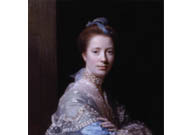 Portrait of Jean Abercromby, Mrs Morrison of Haddo
Allan Ramsay
Allan Ramsay was arguably the most important artist in 18th Century Scotland. He specialised in portraits of women and this one demonstrates his mature style, particularly the stunning lace shawl and necklace. Jean, the daughter of General Abercromby of Glassaugh, sat for the painting around the time of her wedding to Captain George Morison of Haddo, Her married name was mispelled when the frame was created in 1909.
Portrait of Jean Abercromby, Mrs Morrison of Haddo
Allan Ramsay
Allan Ramsay was arguably the most important artist in 18th Century Scotland. He specialised in portraits of women and this one demonstrates his mature style, particularly the stunning lace shawl and necklace. Jean, the daughter of General Abercromby of Glassaugh, sat for the painting around the time of her wedding to Captain George Morison of Haddo, Her married name was mispelled when the frame was created in 1909.
-
42
 Psyche showing…
Psyche showing…
Close
Castle Museum
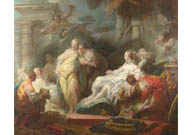 Psyche showing her Sisters her Gifts from Cupid
Jean-Honoré Fragonard
Fragonard was an 18th Century French prodigy, prize-winning student of Frans Boucher and master or many media. This elaborate picture was completed when he was 21. Psyche is showing off sumptuous gifts from her lover, Cupid. Her sisters are green with envy and persuade her to blow Cupid's cover, breaking the conditions of their romance. The centre of the painting is bright and crisp, the edges dark and murky, achieving a sense of foreboding.
Psyche showing her Sisters her Gifts from Cupid
Jean-Honoré Fragonard
Fragonard was an 18th Century French prodigy, prize-winning student of Frans Boucher and master or many media. This elaborate picture was completed when he was 21. Psyche is showing off sumptuous gifts from her lover, Cupid. Her sisters are green with envy and persuade her to blow Cupid's cover, breaking the conditions of their romance. The centre of the painting is bright and crisp, the edges dark and murky, achieving a sense of foreboding.
-
43
 Cavalry Making a…
Cavalry Making a…
Close
Castle Museum
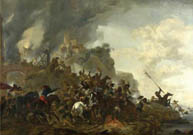 Cavalry Making a Sortie from a Fort on a Hill
Philips Wouwermans
Wouwermans was a prolific and enormously popular Dutch painter of battle and hunting scenes. The white horse, seen from behind, is widely recognised as the artist's trademark. This is one of his largest paintings. The chaotic scene appears to be fictional, but Wouwermans flair for dramatic composition and skill as an animal painter is evident. He doesn't shirk the realities of warfare – the picture features soldiers with amputated limbs.
Cavalry Making a Sortie from a Fort on a Hill
Philips Wouwermans
Wouwermans was a prolific and enormously popular Dutch painter of battle and hunting scenes. The white horse, seen from behind, is widely recognised as the artist's trademark. This is one of his largest paintings. The chaotic scene appears to be fictional, but Wouwermans flair for dramatic composition and skill as an animal painter is evident. He doesn't shirk the realities of warfare – the picture features soldiers with amputated limbs.
-
44
 Madame de Pompadour…
Madame de Pompadour…
Close
Castle Museum
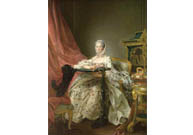 Madame de Pompadour at her Tambour Frame
François-Hubert Drouais
Drouais was the portraitist to the court of Louis XV, and Madame de Pompadour the King's mistress. Drouais painted her head first, presumably from life, adding it to the rest of the picture on a different canvas. Highly educated, she's shown embroidering at a worktable or 'tambour', surrounded by emblems of her interests – books, a mandolin, an artist's folio and her beloved pet dog.
Madame de Pompadour at her Tambour Frame
François-Hubert Drouais
Drouais was the portraitist to the court of Louis XV, and Madame de Pompadour the King's mistress. Drouais painted her head first, presumably from life, adding it to the rest of the picture on a different canvas. Highly educated, she's shown embroidering at a worktable or 'tambour', surrounded by emblems of her interests – books, a mandolin, an artist's folio and her beloved pet dog.
-
45
 Clifford's Tower, York
Clifford's Tower, York
Close
Clifford Street
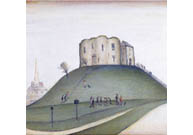 Clifford's Tower, York
Laurence Stephen Lowry
This painting was the result of a commission in 1953 under the Evelyn Award scheme. Each year from 1950 to 1962, a different artist was commissioned by the Gallery to paint a view of York. Lowry chose to paint this view of the 13th century Clifford's Tower on its motte, or mound of earth. In the background are the spire of St Mary's, Castlegate, and a cooling tower, which used to stand on Foss Islands Road.
Clifford's Tower, York
Laurence Stephen Lowry
This painting was the result of a commission in 1953 under the Evelyn Award scheme. Each year from 1950 to 1962, a different artist was commissioned by the Gallery to paint a view of York. Lowry chose to paint this view of the 13th century Clifford's Tower on its motte, or mound of earth. In the background are the spire of St Mary's, Castlegate, and a cooling tower, which used to stand on Foss Islands Road.
-
46
 Calais Pier
Calais Pier
Close
Clifford Street
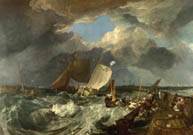 Calais Pier
Laurence Stephen Lowry
Based on Turner's first trip abroad the previous year, Calais pier is born from reality. On a preliminary sketch, Turner noted the seas were so rough he was 'nearly swampt'. The turbulent wave, looming clouds and the sun breaking through on to the ship's sails are all deftly handled. Yet when he first exhibited it at the Royal Academy in 1803, Turner was criticised for not having finished the foreground.
Calais Pier
Laurence Stephen Lowry
Based on Turner's first trip abroad the previous year, Calais pier is born from reality. On a preliminary sketch, Turner noted the seas were so rough he was 'nearly swampt'. The turbulent wave, looming clouds and the sun breaking through on to the ship's sails are all deftly handled. Yet when he first exhibited it at the Royal Academy in 1803, Turner was criticised for not having finished the foreground.
-
47
 Bathers at Asnières
Bathers at Asnières
Close
King's Staith / South Esplanade
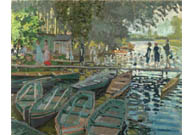 Bathers at Asnières
Georges Seurat
Seurat's mammoth canvas was rejected by the influential Paris salon of 1884 for being too radical because it elevated working-class men to the majestic scale usually reserved for gods and noblemen. Bathers is set on the Seine in North West Paris. Seurat had yet to perfect his pointillist technique, made up of lots of small dots, like a television picture. But he added some later, notably to the boy's hat.
Bathers at Asnières
Georges Seurat
Seurat's mammoth canvas was rejected by the influential Paris salon of 1884 for being too radical because it elevated working-class men to the majestic scale usually reserved for gods and noblemen. Bathers is set on the Seine in North West Paris. Seurat had yet to perfect his pointillist technique, made up of lots of small dots, like a television picture. But he added some later, notably to the boy's hat.
-
48
 The Fighting…
The Fighting…
Close
Ouse Bridge, King's Staith
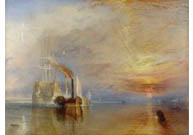 The Fighting Temeraire
Joseph Mallord, William Turner
The full title is The Fighting Temeraire Tugged to her Last Berth to be Broken Up, 1838. It shows the ghostly, 98-gun ship, which played a crucial role in the battle of Trafalgar, on its way to be scrapped. Turner is using artistic license – the masts would already have been chopped for firewood – but his vision conveys the end of an era. Turner called the painting 'my darling', and never sold it. The Fighting Temeraire was voted the nation's favourite painting by Radio 4 listeners.
The Fighting Temeraire
Joseph Mallord, William Turner
The full title is The Fighting Temeraire Tugged to her Last Berth to be Broken Up, 1838. It shows the ghostly, 98-gun ship, which played a crucial role in the battle of Trafalgar, on its way to be scrapped. Turner is using artistic license – the masts would already have been chopped for firewood – but his vision conveys the end of an era. Turner called the painting 'my darling', and never sold it. The Fighting Temeraire was voted the nation's favourite painting by Radio 4 listeners.
-
49
 Portrait of Monsignor…
Portrait of Monsignor…
Close
Spurriergate Centre, Spurriergate
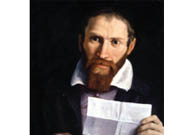 Portrait of Monsignor Agucchi
Annibale Carracci
Giovanni Battista Agucchi was an intellectual from Bologna, Italy. He worked in Rome for the Aldobrandini family and Pope Gregory XV. Agucchi was also associated with a group of artists based there. This informal portrait was painted by his friend, the artist Annibale Carracci. He shows Agucchi life size, tightly framed and emerging from the shadows, evoking a dramatic atmosphere.
Portrait of Monsignor Agucchi
Annibale Carracci
Giovanni Battista Agucchi was an intellectual from Bologna, Italy. He worked in Rome for the Aldobrandini family and Pope Gregory XV. Agucchi was also associated with a group of artists based there. This informal portrait was painted by his friend, the artist Annibale Carracci. He shows Agucchi life size, tightly framed and emerging from the shadows, evoking a dramatic atmosphere.
 Whistlejacket
Close Exhibition Square
Whistlejacket
Close Exhibition Square Whistlejacket
George Stubbs
Owned by the Marquess of Rockingham, Whistlejacket was one of the most celebrated racehorses of the day. Legend has it that George III was to ride the horse in the painting, but Rockingham changed his mind when they had political differences. George Stubbs was a stickler for accuracy. He studied anatomy and dissected horses to get them absolutely right. It worked; allegedly Whistlejacket caught a glimpse of his likeness, and tried to attack the canvas.
Whistlejacket
George Stubbs
Owned by the Marquess of Rockingham, Whistlejacket was one of the most celebrated racehorses of the day. Legend has it that George III was to ride the horse in the painting, but Rockingham changed his mind when they had political differences. George Stubbs was a stickler for accuracy. He studied anatomy and dissected horses to get them absolutely right. It worked; allegedly Whistlejacket caught a glimpse of his likeness, and tried to attack the canvas. Christina of Denmark
Close York Pullman Bus, Bootham Tower
Christina of Denmark
Close York Pullman Bus, Bootham Tower Christina of Denmark,
Christina of Denmark, The Rokeby Venus
Close Bootham Bar
The Rokeby Venus
Close Bootham Bar The Rokeby Venus
Diego Velázquez
Venus, the Goddess of Love, was regarded as a personification of female beauty. She is shown here with her son Cupid, who holds up a mirror for her to look both at herself and at the viewer. This rare Spanish nude was in the collection of the Marqués del Carpio, son of the First Minister of Spain and was presumably displayed privately, thus avoiding the censure of the Spanish Inquisition.
The Rokeby Venus
Diego Velázquez
Venus, the Goddess of Love, was regarded as a personification of female beauty. She is shown here with her son Cupid, who holds up a mirror for her to look both at herself and at the viewer. This rare Spanish nude was in the collection of the Marqués del Carpio, son of the First Minister of Spain and was presumably displayed privately, thus avoiding the censure of the Spanish Inquisition. The Ambassadors
Close Bootham Bar
The Ambassadors
Close Bootham Bar The Ambassadors
Hans Holbein the Younger
This portrait shows two self-satisfied young men. In the pink shirt is Jean de Dinteville, French ambassador to England in 1533. His friend is Georges de Selve, the Bishop of Lavaur. They are surrounded by objects symbolising their education and interests.
The Ambassadors
Hans Holbein the Younger
This portrait shows two self-satisfied young men. In the pink shirt is Jean de Dinteville, French ambassador to England in 1533. His friend is Georges de Selve, the Bishop of Lavaur. They are surrounded by objects symbolising their education and interests. A Scene from 'The…
Close York Theatre Royal
A Scene from 'The…
Close York Theatre Royal A Scene from 'The Careless Husband'
Philip Mercier
This painting was created in 1738 by Philip Mercier, a French-born artist and formally an art dealer, who settled in England and became patronised by Frederick, Prince of Wales. The Careless Husband was a popular comedy by Colley Cibber, a playwright and Poet Laureate, written in 1704.
A Scene from 'The Careless Husband'
Philip Mercier
This painting was created in 1738 by Philip Mercier, a French-born artist and formally an art dealer, who settled in England and became patronised by Frederick, Prince of Wales. The Careless Husband was a popular comedy by Colley Cibber, a playwright and Poet Laureate, written in 1704. Three Men and a Boy
Close The Lodge, Museum Gardens
Three Men and a Boy
Close The Lodge, Museum Gardens Three Men and a Boy
Le Nain brothers
Sometimes, it's hard to tell brothers apart. Never more so than Antoine, Louis and Mathieu Le Nain, who were celebrated artists in Paris in the 1620s. Whether working individually or collaborating, their paintings were signed simply 'Le Nain'. Three Men and a Boy might be a self-portrait of the siblings, though which is which remains a mystery. The young boy's head emerged under many layers of paint during cleaning in 1968.
Three Men and a Boy
Le Nain brothers
Sometimes, it's hard to tell brothers apart. Never more so than Antoine, Louis and Mathieu Le Nain, who were celebrated artists in Paris in the 1620s. Whether working individually or collaborating, their paintings were signed simply 'Le Nain'. Three Men and a Boy might be a self-portrait of the siblings, though which is which remains a mystery. The young boy's head emerged under many layers of paint during cleaning in 1968. An Experiment…
Close The Observatory, Museum Gardens
An Experiment…
Close The Observatory, Museum Gardens An Experiment on a Bird in the Air Pump
Joseph Wright of Derby
Joseph Wright hailed from Derby, a town at the centre of the industrial revolution. This painting shows a dramatic experiment. A rare, white cockatoo is held in a flask from which the air is being removed. Unless it gets oxygen soon, it will die. The reactions around the table are minutely observed; only the distracted lovers remain unmoved.
An Experiment on a Bird in the Air Pump
Joseph Wright of Derby
Joseph Wright hailed from Derby, a town at the centre of the industrial revolution. This painting shows a dramatic experiment. A rare, white cockatoo is held in a flask from which the air is being removed. Unless it gets oxygen soon, it will die. The reactions around the table are minutely observed; only the distracted lovers remain unmoved. Bacchus and Ariadne
Close Yorkshire Museum
Bacchus and Ariadne
Close Yorkshire Museum Bacchus and Ariadne
Titian
Bacchus, God of Wine, emerges from a night out with his crew. He sees Ariadne and falls in love. Ariadne has just been deserted by Theseus after helping defeat the Minotaur (his ship is sailing into the distance). Bacchus elevates her to heaven and turns her into a constellation, represented by the stars above her head. Titian unfolds all the drama in his trademark, blazing colour.
Bacchus and Ariadne
Titian
Bacchus, God of Wine, emerges from a night out with his crew. He sees Ariadne and falls in love. Ariadne has just been deserted by Theseus after helping defeat the Minotaur (his ship is sailing into the distance). Bacchus elevates her to heaven and turns her into a constellation, represented by the stars above her head. Titian unfolds all the drama in his trademark, blazing colour. Salome receives…
Close Abbey Church Ruins
Salome receives…
Close Abbey Church Ruins Salome receives the head of Saint John the Baptist
Michelangelo Merisi da Caravaggio
Painted in Naples not long before Caravaggio's death, this painting depicts the gruesome new testament story of Salome, who danced so entrancingly that king Herod swore he would give her anything. Egged on by her vengeful mother, she asked for the head of John the Baptist on a plate. The pathos and human tragedy of the tale are delivered with exceptional economy and brutal raw power.
Salome receives the head of Saint John the Baptist
Michelangelo Merisi da Caravaggio
Painted in Naples not long before Caravaggio's death, this painting depicts the gruesome new testament story of Salome, who danced so entrancingly that king Herod swore he would give her anything. Egged on by her vengeful mother, she asked for the head of John the Baptist on a plate. The pathos and human tragedy of the tale are delivered with exceptional economy and brutal raw power. The Triumph…
Close Abbey Church Ruins
The Triumph…
Close Abbey Church Ruins The Triumph of Pan
Nicolas Poussin
The Triumph of Pan shows a wild, Pagan celebration in full swing. It's packed with literary and visual references, demonstrating not only Poussin's mastery of painting but also his deep, classical scholarship. The work belonged to Cardinal Richelieu, and was housed in an extravagant room dripping with fine art and gilt décor.
The Triumph of Pan
Nicolas Poussin
The Triumph of Pan shows a wild, Pagan celebration in full swing. It's packed with literary and visual references, demonstrating not only Poussin's mastery of painting but also his deep, classical scholarship. The work belonged to Cardinal Richelieu, and was housed in an extravagant room dripping with fine art and gilt décor. The Arnolfini…
Close The Hospitium, Museum Gardens
The Arnolfini…
Close The Hospitium, Museum Gardens The Arnolfini Portrait
Jan van Eyck
Van Eyck used oil paints in a dramatic new way, pushing the medium to its limits and achieving all kinds of textures and effects. His double portrait of the wealthy merchant Giovanni di Nicolao Arnolfini and wife isn't as was once thought a wedding portrait. Nor is she pregnant, it's just the fashion of the time. Anticipating modern graffiti, the ornate Latin signature over the mirror reads 'Jan van Eyck was here 1434'.
The Arnolfini Portrait
Jan van Eyck
Van Eyck used oil paints in a dramatic new way, pushing the medium to its limits and achieving all kinds of textures and effects. His double portrait of the wealthy merchant Giovanni di Nicolao Arnolfini and wife isn't as was once thought a wedding portrait. Nor is she pregnant, it's just the fashion of the time. Anticipating modern graffiti, the ornate Latin signature over the mirror reads 'Jan van Eyck was here 1434'. Seaport with the…
Close The Hospitium, Museum Gardens
Seaport with the…
Close The Hospitium, Museum Gardens Seaport with the Embarkation of Saint Ursula
Claude Lorrain
It's thought that Claude emigrated to Rome as a boy. His reinventions of a golden age profoundly influenced landscape painting, and painting itself, particularly in 18th Century England. According to legend, Saint Ursula (a British princess) made a pilgrimage to Rome, with eleven thousand virgins. On their return, pagan huns slaughtered them when Ursula refused to marry their Chieftain. This picture shows her in happier times, radiant in the golden morning sun.
Seaport with the Embarkation of Saint Ursula
Claude Lorrain
It's thought that Claude emigrated to Rome as a boy. His reinventions of a golden age profoundly influenced landscape painting, and painting itself, particularly in 18th Century England. According to legend, Saint Ursula (a British princess) made a pilgrimage to Rome, with eleven thousand virgins. On their return, pagan huns slaughtered them when Ursula refused to marry their Chieftain. This picture shows her in happier times, radiant in the golden morning sun. The Skiff
Close Water Tower,
The Skiff
Close Water Tower, The Skiff
Pierre-Auguste Renoir
The Skiff is an impressionist vision of suburban leisure, as two young women enjoy a lazy Summer's day on the river. The dazzling blue of the water and the bright chrome orange of the boat also provided an opportunity for Renoir to test impressionist colour theory. They are opposites on the colour scale and create an intense contrast when put together.
The Skiff
Pierre-Auguste Renoir
The Skiff is an impressionist vision of suburban leisure, as two young women enjoy a lazy Summer's day on the river. The dazzling blue of the water and the bright chrome orange of the boat also provided an opportunity for Renoir to test impressionist colour theory. They are opposites on the colour scale and create an intense contrast when put together. Bathers at La…
Close Water Tower,
Bathers at La…
Close Water Tower, Bathers at La Grenouillère
Claude-Oscar Monet
In the Summer of 1869, Monet worked alongside Renoir at La Grenouill, a rather risqué bohemian resort on the Seine just outside Paris. Fresh, direct and experimental, Bathers at La Genouillere became one of impressionism's most famous pictures. But it was only a quick sketch for a more ambitious composition (now lost), to be painted back in the studio. The distinctive style couldn't have been achieved without recent innovations in artists' materials - portable tubes in oil paint and flat brushes.
Bathers at La Grenouillère
Claude-Oscar Monet
In the Summer of 1869, Monet worked alongside Renoir at La Grenouill, a rather risqué bohemian resort on the Seine just outside Paris. Fresh, direct and experimental, Bathers at La Genouillere became one of impressionism's most famous pictures. But it was only a quick sketch for a more ambitious composition (now lost), to be painted back in the studio. The distinctive style couldn't have been achieved without recent innovations in artists' materials - portable tubes in oil paint and flat brushes. A Young Woman…
Close Nailed on Beauty, 11 Lendal
A Young Woman…
Close Nailed on Beauty, 11 Lendal A Young Woman Standing at a Virginal
Johannes Vermeer
Only around 30 paintings by Vermeer are known today, because he worked very slowly, ran an inn and an art dealership, and died aged 43. This interior bears all the hallmarks of his paintings. The arrangement is fastidious, a finely balanced geometry containing beautifully worked details. The woman, looking expectantly in our direction, plays music reminding her of an absent man, signified by the empty chair. The painting of Cupid holding up a single playing card symbolises fidelity.
A Young Woman Standing at a Virginal
Johannes Vermeer
Only around 30 paintings by Vermeer are known today, because he worked very slowly, ran an inn and an art dealership, and died aged 43. This interior bears all the hallmarks of his paintings. The arrangement is fastidious, a finely balanced geometry containing beautifully worked details. The woman, looking expectantly in our direction, plays music reminding her of an absent man, signified by the empty chair. The painting of Cupid holding up a single playing card symbolises fidelity. The Doge Leonardo…
Close The Guildhall
The Doge Leonardo…
Close The Guildhall The Doge Leonardo Loredan
Giovanni Bellini
Bellini hailed from the leading artistic dynasty of 15th Century Venice, following his father and brother with this official state commission Doge Leonardo Loredan was top dog in the Venetian republic, shown here in full regalia. Bellini tells us about him subtly: the shadowed side of the face is gentler-looking than the starker left side, and the setting sun is reflected in his eyes - perhaps a comment on the doge's advancing years.
The Doge Leonardo Loredan
Giovanni Bellini
Bellini hailed from the leading artistic dynasty of 15th Century Venice, following his father and brother with this official state commission Doge Leonardo Loredan was top dog in the Venetian republic, shown here in full regalia. Bellini tells us about him subtly: the shadowed side of the face is gentler-looking than the starker left side, and the setting sun is reflected in his eyes - perhaps a comment on the doge's advancing years. Venus and Mars
Close City Screen, Coney Street
Venus and Mars
Close City Screen, Coney Street Venus and Mars
Sandro Botticelli
Botticelli is famed for his religious paintings. Venus and Mars, however, is earthy, packed with sexual innuendo, and was probably a piece of bedroom furniture. Venus, Goddess of Love, has conquered Mars, God of War, with her over-whelming beauty. Clearly exhausted, a post-coital Mars sleeps with Venus looking on. Meanwhile, mischievous satyrs make off with his lance and helmet, both phallic symbols, suggesting a 'Make Love not War' message.
Venus and Mars
Sandro Botticelli
Botticelli is famed for his religious paintings. Venus and Mars, however, is earthy, packed with sexual innuendo, and was probably a piece of bedroom furniture. Venus, Goddess of Love, has conquered Mars, God of War, with her over-whelming beauty. Clearly exhausted, a post-coital Mars sleeps with Venus looking on. Meanwhile, mischievous satyrs make off with his lance and helmet, both phallic symbols, suggesting a 'Make Love not War' message. The Entombment
Close St Helen's Graveyard, Davygate
The Entombment
Close St Helen's Graveyard, Davygate The Entombment
Michelangelo
This early work by Michelangelo, the original Renaissance man, was intended as an altarpiece, but was never finished. Christ, in the centre, is supported by John the Evangelist, Joseph of Arimathea and Nicodemus. Mary Magdelene and Mary Salome (a holy woman) are also shown. The empty outline on the right is reserved for the Virgin Mary Michelangelo may have been waiting for rare and costly ultramarine pigment for her traditional blue cloak.
The Entombment
Michelangelo
This early work by Michelangelo, the original Renaissance man, was intended as an altarpiece, but was never finished. Christ, in the centre, is supported by John the Evangelist, Joseph of Arimathea and Nicodemus. Mary Magdelene and Mary Salome (a holy woman) are also shown. The empty outline on the right is reserved for the Virgin Mary Michelangelo may have been waiting for rare and costly ultramarine pigment for her traditional blue cloak. Lady Cockburn…
Close St Helen's Graveyard, Davygate
Lady Cockburn…
Close St Helen's Graveyard, Davygate Lady Cockburn and her Three Eldest Sons
Sir Joshua Reynolds
Son of a village schoolmaster, Joshua Reynolds rose to become the most sought-after portrait painter of his age, a founder of the Royal Academy, and friend to the most eminent men of letters in England. Reynolds idealised his subjects, portraying them in a classical context. Here, Lady Cockburn is cast as charity, who is traditionally shown with three children. James, on the left, is based on Cupid, as seen in the Rokeby Venus by Veluez.
Lady Cockburn and her Three Eldest Sons
Sir Joshua Reynolds
Son of a village schoolmaster, Joshua Reynolds rose to become the most sought-after portrait painter of his age, a founder of the Royal Academy, and friend to the most eminent men of letters in England. Reynolds idealised his subjects, portraying them in a classical context. Here, Lady Cockburn is cast as charity, who is traditionally shown with three children. James, on the left, is based on Cupid, as seen in the Rokeby Venus by Veluez. Sunflowers
Close St Helen's Church, St Helen's Square
Sunflowers
Close St Helen's Church, St Helen's Square Sunflowers
Vincent Van Gogh
Van Gogh painted a series of sunflowers anticipating the arrival of his friend, the poet-artist Paul Gauguin, to his house in Arles, France in 1888. The painting is strikingly yellow, using newly invented pigments that made vibrant colours possible. Ironically, yellow symbolised happiness for Van Gogh, because it was the heated rows he had while working with Gaughin that finally tipped him into despair and madness.
Sunflowers
Vincent Van Gogh
Van Gogh painted a series of sunflowers anticipating the arrival of his friend, the poet-artist Paul Gauguin, to his house in Arles, France in 1888. The painting is strikingly yellow, using newly invented pigments that made vibrant colours possible. Ironically, yellow symbolised happiness for Van Gogh, because it was the heated rows he had while working with Gaughin that finally tipped him into despair and madness. The Supper at Emmaus
Close Dean Court Hotel, High Petergate
The Supper at Emmaus
Close Dean Court Hotel, High Petergate The Supper at Emmaus
Michelangelo Merisi da Caravaggio
Some see in Caragaggio's paintings a reflection of his character. A volatile visionary, Caravaggio swaggered through the streets of Rome with a sword at his side. The supper at Emmaus depicts Christ's appearance to his disciples after the resurrection. Their outstretched arms draw us into the painting, including us in the event. It still has the power to dazzle to this day. As Holbein immortalizes them in art, he reminds us that we all die. Stand to the right of the painting, you should see a skull, between the ambassadors, signifying the brevity of life.
The Supper at Emmaus
Michelangelo Merisi da Caravaggio
Some see in Caragaggio's paintings a reflection of his character. A volatile visionary, Caravaggio swaggered through the streets of Rome with a sword at his side. The supper at Emmaus depicts Christ's appearance to his disciples after the resurrection. Their outstretched arms draw us into the painting, including us in the event. It still has the power to dazzle to this day. As Holbein immortalizes them in art, he reminds us that we all die. Stand to the right of the painting, you should see a skull, between the ambassadors, signifying the brevity of life. Surprised! (Tiger in…
Close 36 High Petergate
Surprised! (Tiger in…
Close 36 High Petergate Surprised! (Tiger in a Tropical Storm)
Henri Rousseau
Never one to play by the rules, Rousseau discovered art in his forties, after careers as a regimental bandsman and toll collector. He claimed his stylised, highly patterned jungle paintings were informed by first-hand experience with the French army in Mexico, but they were more likely inspired by prints, visits to the local botanical gardens and humble house plants. When he exhibited this dreamlike canvas in 1891, Rousseau called it 'surpris!' suggesting explorers outside the picture frame about to be pounced on by the tiger.
Surprised! (Tiger in a Tropical Storm)
Henri Rousseau
Never one to play by the rules, Rousseau discovered art in his forties, after careers as a regimental bandsman and toll collector. He claimed his stylised, highly patterned jungle paintings were informed by first-hand experience with the French army in Mexico, but they were more likely inspired by prints, visits to the local botanical gardens and humble house plants. When he exhibited this dreamlike canvas in 1891, Rousseau called it 'surpris!' suggesting explorers outside the picture frame about to be pounced on by the tiger. A Wheatfield…
Close St Michael le Belfrey
A Wheatfield…
Close St Michael le Belfrey A Wheatfield, with Cypresses
Vincent Van Gogh
After his breakdown and self-mutilation, Vincent Van Gogh checked into the St-R asylum, near Arles. He completed around 150 canvasses in the asylum that year. Among them were three versions of the turbulent, swirling Wheatfield with Cypresses. The blazing yellow wheat field represents the life cycle and creative force. The tall, dark cypress tree native to Provence is associated with death. Soon after leaving St-R, Van Gogh shot himself in a wheat field. He died two days later.
A Wheatfield, with Cypresses
Vincent Van Gogh
After his breakdown and self-mutilation, Vincent Van Gogh checked into the St-R asylum, near Arles. He completed around 150 canvasses in the asylum that year. Among them were three versions of the turbulent, swirling Wheatfield with Cypresses. The blazing yellow wheat field represents the life cycle and creative force. The tall, dark cypress tree native to Provence is associated with death. Soon after leaving St-R, Van Gogh shot himself in a wheat field. He died two days later. Self Portrait at the…
Close Shared Earth, Petergate
Self Portrait at the…
Close Shared Earth, Petergate Self Portrait at the Age of 34
Rembrandt
One of Rembrandt's favourite subjects was himself; he painted between 50 and 60 self-portraits. Here, Rembrandt is at his peak. He's dressed in exotic and expensive garments - the 17th Century equivalent of bling. His pose mimics Titan's Man with a quilted sleeve inviting direct comparison with this Italian master.
Self Portrait at the Age of 34
Rembrandt
One of Rembrandt's favourite subjects was himself; he painted between 50 and 60 self-portraits. Here, Rembrandt is at his peak. He's dressed in exotic and expensive garments - the 17th Century equivalent of bling. His pose mimics Titan's Man with a quilted sleeve inviting direct comparison with this Italian master. Corner of a Café…
Close Snickleway, Stonegate to Grape Lane
Corner of a Café…
Close Snickleway, Stonegate to Grape Lane Corner of a Café-Concert
Edouard Manet
Manet's paintings caused a stir, making him a hero to the emerging impressionists who were looking to shake up the status quo. Corner of a café-concert is the right half of a painting, enlarged and with new background added. It captures one of Manet's favourite watering holes, the brasserie Reichshoffen on the Boulevard Rochechouart. Manet's observations of 19th Century life are fluid and rough-edged, capturing a real sense of Parisian life.
Corner of a Café-Concert
Edouard Manet
Manet's paintings caused a stir, making him a hero to the emerging impressionists who were looking to shake up the status quo. Corner of a café-concert is the right half of a painting, enlarged and with new background added. It captures one of Manet's favourite watering holes, the brasserie Reichshoffen on the Boulevard Rochechouart. Manet's observations of 19th Century life are fluid and rough-edged, capturing a real sense of Parisian life. Allegory with…
Close Coffee Yard
Allegory with…
Close Coffee Yard Allegory with Venus and Cupid
Bronzino
Bronzino was the ultra-fashionable court painter to the Medici family. Duke Cosimo was responsible for commissioning this complex allegory as a carefully considered present for the King of France, a man with a notorious lust for flesh. Packed with riddles and symbolism, it would have given him plenty of excuse to ogle the sensual bodies of the cavorting Venus and Cupid, while decoding its finer meaning.
Allegory with Venus and Cupid
Bronzino
Bronzino was the ultra-fashionable court painter to the Medici family. Duke Cosimo was responsible for commissioning this complex allegory as a carefully considered present for the King of France, a man with a notorious lust for flesh. Packed with riddles and symbolism, it would have given him plenty of excuse to ogle the sensual bodies of the cavorting Venus and Cupid, while decoding its finer meaning. A Grotesque…
Close Coffee Yard
A Grotesque…
Close Coffee Yard A Grotesque Old Woman
Bronzino
Massys was a cultural magpie. A leading painter in Antwerp by 1510, he drew inspiration from local Flemish artists, among others. It's possible that the inspiration for this painting came from the faces drawn in Leonardo's notebooks. The painting is thought to be a satire on vain old women dressing too youthfully. She became the inspiration to John Tenniel, illustrator of Alice in Wonderland, for his ugly duchess.
A Grotesque Old Woman
Bronzino
Massys was a cultural magpie. A leading painter in Antwerp by 1510, he drew inspiration from local Flemish artists, among others. It's possible that the inspiration for this painting came from the faces drawn in Leonardo's notebooks. The painting is thought to be a satire on vain old women dressing too youthfully. She became the inspiration to John Tenniel, illustrator of Alice in Wonderland, for his ugly duchess. Samson and Delilah
Close St Sampson's Church (Annexe)
Samson and Delilah
Close St Sampson's Church (Annexe) Samson and Delilah
Peter Paul Rubens
Like a still from a film, Rubens' painting of Delilah and Samson freeze-frames the drama of one moment in time. It's a retelling of the powerful Old Testament story, where the mighty Jewish hero falls for a prostitute, and reveals that the secret of his strength lies in his uncut locks. Having exhausted him after a night of passion, Delilah cuts his hair, and hands him over emasculated to his enemies, the Philistines.
Samson and Delilah
Peter Paul Rubens
Like a still from a film, Rubens' painting of Delilah and Samson freeze-frames the drama of one moment in time. It's a retelling of the powerful Old Testament story, where the mighty Jewish hero falls for a prostitute, and reveals that the secret of his strength lies in his uncut locks. Having exhausted him after a night of passion, Delilah cuts his hair, and hands him over emasculated to his enemies, the Philistines. The Four Elements…
Close 4 Jubbergate
The Four Elements…
Close 4 Jubbergate The Four Elements: Earth
Joachim Beuckelaer
Beuckelaer was a still life pioneer. At first glance, this picture appears to be of a common food market. If you look at the top left-hand corner, however, the holy family can be made out crossing a bridge, adding a religious message to the scene. A warning against earthly gratification, the over-abundance of fruit and vegetables in the foreground is painted with tempting sensuality. There are 16 different types of produce shown, tumbling out of the painting towards the viewer.
The Four Elements: Earth
Joachim Beuckelaer
Beuckelaer was a still life pioneer. At first glance, this picture appears to be of a common food market. If you look at the top left-hand corner, however, the holy family can be made out crossing a bridge, adding a religious message to the scene. A warning against earthly gratification, the over-abundance of fruit and vegetables in the foreground is painted with tempting sensuality. There are 16 different types of produce shown, tumbling out of the painting towards the viewer. An Extensive…
Close Newgate, The Shambles
An Extensive…
Close Newgate, The Shambles An Extensive Landscape with a Road by a River
Philips Koninck
Koninck may have been a pupil of Rembrandt's. His sweeping, low-skied, panoramic views are part of the tradition of Dutch landscape art. This landscape could be real, or conjured from Koninck's imagination. Varied application of the paint suggests depth; rough at the front, detailed in the middle, with bold strokes of colour in the distance. Koninck often asked a fellow artist to place figures into the landscape for him, but seems to have painted these himself.
An Extensive Landscape with a Road by a River
Philips Koninck
Koninck may have been a pupil of Rembrandt's. His sweeping, low-skied, panoramic views are part of the tradition of Dutch landscape art. This landscape could be real, or conjured from Koninck's imagination. Varied application of the paint suggests depth; rough at the front, detailed in the middle, with bold strokes of colour in the distance. Koninck often asked a fellow artist to place figures into the landscape for him, but seems to have painted these himself. Philip IV of Spain…
Close St Crux, The Shambles
Philip IV of Spain…
Close St Crux, The Shambles Philip IV of Spain in Brown and Silver
Diego Velázquez
Veluez became a court painter when he was 24 and Philip IV was just 18. When Veluez left Madrid to study in Italy, Philip refused to be portrayed by anyone else. This portrait was painted soon after Veluez's return in 1631. The pose is confident, but there's timidity in Philip's eyes. Freely brushed blobs and strokes over the costume give an impression of glinting silver embroidery over rich cloth.
Philip IV of Spain in Brown and Silver
Diego Velázquez
Veluez became a court painter when he was 24 and Philip IV was just 18. When Veluez left Madrid to study in Italy, Philip refused to be portrayed by anyone else. This portrait was painted soon after Veluez's return in 1631. The pose is confident, but there's timidity in Philip's eyes. Freely brushed blobs and strokes over the costume give an impression of glinting silver embroidery over rich cloth.
 Saint Michael…
Close Marks and Spencer, The Shambles
Saint Michael…
Close Marks and Spencer, The Shambles Saint Michael Triumphant over the Devil
Bartolomé Bermejo
Bartolomermejo was a loud, proud 15th Century redhead, signing his pictures Bartolomeus Ruebus ('Red Bartholomew'). Antonio Juan, the feudal Lord of Tous, near Valencia, commissioned this painting as an altarpiece. He's on the left watching as St Michael triumphs over a devil that, although taken from the Book of Revelations, is a creature from Bermeio's imagination.
Saint Michael Triumphant over the Devil
Bartolomé Bermejo
Bartolomermejo was a loud, proud 15th Century redhead, signing his pictures Bartolomeus Ruebus ('Red Bartholomew'). Antonio Juan, the feudal Lord of Tous, near Valencia, commissioned this painting as an altarpiece. He's on the left watching as St Michael triumphs over a devil that, although taken from the Book of Revelations, is a creature from Bermeio's imagination.
 Madame Moitessier
Close Lady Peckett’s Yard, Fossgate
Madame Moitessier
Close Lady Peckett’s Yard, Fossgate Madame Moitessier
Jean-Auguste-Dominique Ingres
Ingres' opulent portrait of Madame Moitessier very nearly never happened. Approached by her rich banker husband in 1847, Ingres refused to take on the commission. But once he'd seen the fragrant Inès he was smitten and changed his mind. Even then, it took him 12 years to complete, by which time he was 76. The pose is inspired by an ancient Roman wall painting of a goddess, suggesting Ingres saw her as an ideal of classical beauty.
Madame Moitessier
Jean-Auguste-Dominique Ingres
Ingres' opulent portrait of Madame Moitessier very nearly never happened. Approached by her rich banker husband in 1847, Ingres refused to take on the commission. But once he'd seen the fragrant Inès he was smitten and changed his mind. Even then, it took him 12 years to complete, by which time he was 76. The pose is inspired by an ancient Roman wall painting of a goddess, suggesting Ingres saw her as an ideal of classical beauty.
 Belshazzar's Feast
Close All Saints, Pavement
Belshazzar's Feast
Close All Saints, Pavement Belshazzar's Feast
Rembrandt
Rembrandt wanted to be a religious painter but in the strictly Calvinist Dutch republic the adornment of churches was forbidden, so he recreated bible scenes for private clients instead. This painting tells the story of the king of Babylon, who gave a feast for his nobles using sacred vessels looted from the temple in Jerusalem. A divine hand appeared, carving an inscription foretelling the ruin of Belshazzar's kingdom. Framed and lit like a movie still, Rembrandt skillfully captures the dread and horror of the guests.
Belshazzar's Feast
Rembrandt
Rembrandt wanted to be a religious painter but in the strictly Calvinist Dutch republic the adornment of churches was forbidden, so he recreated bible scenes for private clients instead. This painting tells the story of the king of Babylon, who gave a feast for his nobles using sacred vessels looted from the temple in Jerusalem. A divine hand appeared, carving an inscription foretelling the ruin of Belshazzar's kingdom. Framed and lit like a movie still, Rembrandt skillfully captures the dread and horror of the guests.
 Four Officers of the…
Close Merchant Adventurers' Hall
Four Officers of the…
Close Merchant Adventurers' Hall Four Officers of the Amsterdam Coopers' and Wine-rackers' Guild
Gerbrand van den Eeckhout
Eeckhout was one of Rembrandt's favourite pupils. Though he had his master's style off to a tee, he wasn't as daringly original. The painting is typical of group portraits of the age, depicting prosperous, businessmen in the equivalent of a team photo. This particular guild included the men who made barrels for the wine imported into Amsterdam, and others who sampled and bottled it. One of the gents pictured is Eeckhout's brother.
Four Officers of the Amsterdam Coopers' and Wine-rackers' Guild
Gerbrand van den Eeckhout
Eeckhout was one of Rembrandt's favourite pupils. Though he had his master's style off to a tee, he wasn't as daringly original. The painting is typical of group portraits of the age, depicting prosperous, businessmen in the equivalent of a team photo. This particular guild included the men who made barrels for the wine imported into Amsterdam, and others who sampled and bottled it. One of the gents pictured is Eeckhout's brother.
 The Hay Wain
Close Coppergate Centre
The Hay Wain
Close Coppergate Centre The Hay Wain
John Constable
Now one of the nation's best-loved paintings, when Constable first exhibited the Hay Wain in the early 1820s, he didn't get a sniff of a sale. He had to take it to France to find a buyer. The setting is the River Stour near Flatford in Suffolk, which remains remarkably unspoiled today. the rustic cart (or hay wain) is soaking its wooden wheels to stop them cracking on a long, hot journey.
The Hay Wain
John Constable
Now one of the nation's best-loved paintings, when Constable first exhibited the Hay Wain in the early 1820s, he didn't get a sniff of a sale. He had to take it to France to find a buyer. The setting is the River Stour near Flatford in Suffolk, which remains remarkably unspoiled today. the rustic cart (or hay wain) is soaking its wooden wheels to stop them cracking on a long, hot journey.
 The Water-Lily Pond
Close Coppergate Centre
The Water-Lily Pond
Close Coppergate Centre The Water-Lily Pond
Claude-Oscar Monet
The impressionists were obsessed with all things Japanese. Once he became rich, Monet painstakingly cultivated an oriental water garden, complete with simple arching bridge, on his estate at Giverney in rural France. Then he painted it at least 18 times, at various times of the day, all from the same perspective. They are a triumph of vision and technique, seemingly disjointed fragments coming together to form a shimmering whole.
The Water-Lily Pond
Claude-Oscar Monet
The impressionists were obsessed with all things Japanese. Once he became rich, Monet painstakingly cultivated an oriental water garden, complete with simple arching bridge, on his estate at Giverney in rural France. Then he painted it at least 18 times, at various times of the day, all from the same perspective. They are a triumph of vision and technique, seemingly disjointed fragments coming together to form a shimmering whole.
 After the Bath…
Close Fenwicks, Coppergate Centre
After the Bath…
Close Fenwicks, Coppergate Centre After the Bath, Woman drying herself
Hilaire-Germain-Edgar Degas
In later life, eye trouble forced Degas to stick to indoor subjects. He favoured bright pastels, partly because they produced vivid, modern colours, but he could also see them more easily. The woman pictured is going about an intimate everyday act, seemingly unaware of the viewer. Degas seems to have extended his composition while working on it, adding pieces of paper. He's exploited the flexibility of pastels to create sumptuous textures and blurred contours suggesting movement.
After the Bath, Woman drying herself
Hilaire-Germain-Edgar Degas
In later life, eye trouble forced Degas to stick to indoor subjects. He favoured bright pastels, partly because they produced vivid, modern colours, but he could also see them more easily. The woman pictured is going about an intimate everyday act, seemingly unaware of the viewer. Degas seems to have extended his composition while working on it, adding pieces of paper. He's exploited the flexibility of pastels to create sumptuous textures and blurred contours suggesting movement.
 Mr and Mrs Andrews
Close Fairfax House, Coppergate Centre
Mr and Mrs Andrews
Close Fairfax House, Coppergate Centre Mr and Mrs Andrews
Thomas Gainsborough
This portrait is a masterpiece from Gainsborough's early years, painted soon after the marriage of Robert Andrews to his wife Frances Mary. The portrait in an open-air setting is typical of Gainsborough's early works. Mr Andrews' satisfaction with his farmlands pales in comparison to the passion with which Gainsborough paints the gold and green fields beyond, allowing him to display his skills as a painter of changing weather and glorious scenery.
Mr and Mrs Andrews
Thomas Gainsborough
This portrait is a masterpiece from Gainsborough's early years, painted soon after the marriage of Robert Andrews to his wife Frances Mary. The portrait in an open-air setting is typical of Gainsborough's early works. Mr Andrews' satisfaction with his farmlands pales in comparison to the passion with which Gainsborough paints the gold and green fields beyond, allowing him to display his skills as a painter of changing weather and glorious scenery.
 The Virgin of the Rocks
Close York St Mary's
The Virgin of the Rocks
Close York St Mary's The Virgin of the Rocks
Leonardo da Vinci
The Virgin of the Rocks is typical of Leonardo's brilliant, yet mysterious paintings. The scene shows the Virgin Mary, the Christ child, John the Baptist as a baby, and an angel in a cavernous, watery landscape. Commissioned as an altarpiece, it is one of two versions. The other hangs in the Louvre and was recently featured in the Da Vinci Code.
The Virgin of the Rocks
Leonardo da Vinci
The Virgin of the Rocks is typical of Leonardo's brilliant, yet mysterious paintings. The scene shows the Virgin Mary, the Christ child, John the Baptist as a baby, and an angel in a cavernous, watery landscape. Commissioned as an altarpiece, it is one of two versions. The other hangs in the Louvre and was recently featured in the Da Vinci Code.
 Portrait of Jean…
Close Fairfax House, Castlegate
Portrait of Jean…
Close Fairfax House, Castlegate Portrait of Jean Abercromby, Mrs Morrison of Haddo
Allan Ramsay
Allan Ramsay was arguably the most important artist in 18th Century Scotland. He specialised in portraits of women and this one demonstrates his mature style, particularly the stunning lace shawl and necklace. Jean, the daughter of General Abercromby of Glassaugh, sat for the painting around the time of her wedding to Captain George Morison of Haddo, Her married name was mispelled when the frame was created in 1909.
Portrait of Jean Abercromby, Mrs Morrison of Haddo
Allan Ramsay
Allan Ramsay was arguably the most important artist in 18th Century Scotland. He specialised in portraits of women and this one demonstrates his mature style, particularly the stunning lace shawl and necklace. Jean, the daughter of General Abercromby of Glassaugh, sat for the painting around the time of her wedding to Captain George Morison of Haddo, Her married name was mispelled when the frame was created in 1909.
 Psyche showing…
Close Castle Museum
Psyche showing…
Close Castle Museum Psyche showing her Sisters her Gifts from Cupid
Jean-Honoré Fragonard
Fragonard was an 18th Century French prodigy, prize-winning student of Frans Boucher and master or many media. This elaborate picture was completed when he was 21. Psyche is showing off sumptuous gifts from her lover, Cupid. Her sisters are green with envy and persuade her to blow Cupid's cover, breaking the conditions of their romance. The centre of the painting is bright and crisp, the edges dark and murky, achieving a sense of foreboding.
Psyche showing her Sisters her Gifts from Cupid
Jean-Honoré Fragonard
Fragonard was an 18th Century French prodigy, prize-winning student of Frans Boucher and master or many media. This elaborate picture was completed when he was 21. Psyche is showing off sumptuous gifts from her lover, Cupid. Her sisters are green with envy and persuade her to blow Cupid's cover, breaking the conditions of their romance. The centre of the painting is bright and crisp, the edges dark and murky, achieving a sense of foreboding.
 Cavalry Making a…
Close Castle Museum
Cavalry Making a…
Close Castle Museum Cavalry Making a Sortie from a Fort on a Hill
Philips Wouwermans
Wouwermans was a prolific and enormously popular Dutch painter of battle and hunting scenes. The white horse, seen from behind, is widely recognised as the artist's trademark. This is one of his largest paintings. The chaotic scene appears to be fictional, but Wouwermans flair for dramatic composition and skill as an animal painter is evident. He doesn't shirk the realities of warfare – the picture features soldiers with amputated limbs.
Cavalry Making a Sortie from a Fort on a Hill
Philips Wouwermans
Wouwermans was a prolific and enormously popular Dutch painter of battle and hunting scenes. The white horse, seen from behind, is widely recognised as the artist's trademark. This is one of his largest paintings. The chaotic scene appears to be fictional, but Wouwermans flair for dramatic composition and skill as an animal painter is evident. He doesn't shirk the realities of warfare – the picture features soldiers with amputated limbs.
 Madame de Pompadour…
Close Castle Museum
Madame de Pompadour…
Close Castle Museum Madame de Pompadour at her Tambour Frame
François-Hubert Drouais
Drouais was the portraitist to the court of Louis XV, and Madame de Pompadour the King's mistress. Drouais painted her head first, presumably from life, adding it to the rest of the picture on a different canvas. Highly educated, she's shown embroidering at a worktable or 'tambour', surrounded by emblems of her interests – books, a mandolin, an artist's folio and her beloved pet dog.
Madame de Pompadour at her Tambour Frame
François-Hubert Drouais
Drouais was the portraitist to the court of Louis XV, and Madame de Pompadour the King's mistress. Drouais painted her head first, presumably from life, adding it to the rest of the picture on a different canvas. Highly educated, she's shown embroidering at a worktable or 'tambour', surrounded by emblems of her interests – books, a mandolin, an artist's folio and her beloved pet dog.
 Clifford's Tower, York
Close Clifford Street
Clifford's Tower, York
Close Clifford Street Clifford's Tower, York
Laurence Stephen Lowry
This painting was the result of a commission in 1953 under the Evelyn Award scheme. Each year from 1950 to 1962, a different artist was commissioned by the Gallery to paint a view of York. Lowry chose to paint this view of the 13th century Clifford's Tower on its motte, or mound of earth. In the background are the spire of St Mary's, Castlegate, and a cooling tower, which used to stand on Foss Islands Road.
Clifford's Tower, York
Laurence Stephen Lowry
This painting was the result of a commission in 1953 under the Evelyn Award scheme. Each year from 1950 to 1962, a different artist was commissioned by the Gallery to paint a view of York. Lowry chose to paint this view of the 13th century Clifford's Tower on its motte, or mound of earth. In the background are the spire of St Mary's, Castlegate, and a cooling tower, which used to stand on Foss Islands Road.
 Calais Pier
Close Clifford Street
Calais Pier
Close Clifford Street Calais Pier
Laurence Stephen Lowry
Based on Turner's first trip abroad the previous year, Calais pier is born from reality. On a preliminary sketch, Turner noted the seas were so rough he was 'nearly swampt'. The turbulent wave, looming clouds and the sun breaking through on to the ship's sails are all deftly handled. Yet when he first exhibited it at the Royal Academy in 1803, Turner was criticised for not having finished the foreground.
Calais Pier
Laurence Stephen Lowry
Based on Turner's first trip abroad the previous year, Calais pier is born from reality. On a preliminary sketch, Turner noted the seas were so rough he was 'nearly swampt'. The turbulent wave, looming clouds and the sun breaking through on to the ship's sails are all deftly handled. Yet when he first exhibited it at the Royal Academy in 1803, Turner was criticised for not having finished the foreground.
 Bathers at Asnières
Close King's Staith / South Esplanade
Bathers at Asnières
Close King's Staith / South Esplanade Bathers at Asnières
Georges Seurat
Seurat's mammoth canvas was rejected by the influential Paris salon of 1884 for being too radical because it elevated working-class men to the majestic scale usually reserved for gods and noblemen. Bathers is set on the Seine in North West Paris. Seurat had yet to perfect his pointillist technique, made up of lots of small dots, like a television picture. But he added some later, notably to the boy's hat.
Bathers at Asnières
Georges Seurat
Seurat's mammoth canvas was rejected by the influential Paris salon of 1884 for being too radical because it elevated working-class men to the majestic scale usually reserved for gods and noblemen. Bathers is set on the Seine in North West Paris. Seurat had yet to perfect his pointillist technique, made up of lots of small dots, like a television picture. But he added some later, notably to the boy's hat.
 The Fighting…
Close Ouse Bridge, King's Staith
The Fighting…
Close Ouse Bridge, King's Staith The Fighting Temeraire
Joseph Mallord, William Turner
The full title is The Fighting Temeraire Tugged to her Last Berth to be Broken Up, 1838. It shows the ghostly, 98-gun ship, which played a crucial role in the battle of Trafalgar, on its way to be scrapped. Turner is using artistic license – the masts would already have been chopped for firewood – but his vision conveys the end of an era. Turner called the painting 'my darling', and never sold it. The Fighting Temeraire was voted the nation's favourite painting by Radio 4 listeners.
The Fighting Temeraire
Joseph Mallord, William Turner
The full title is The Fighting Temeraire Tugged to her Last Berth to be Broken Up, 1838. It shows the ghostly, 98-gun ship, which played a crucial role in the battle of Trafalgar, on its way to be scrapped. Turner is using artistic license – the masts would already have been chopped for firewood – but his vision conveys the end of an era. Turner called the painting 'my darling', and never sold it. The Fighting Temeraire was voted the nation's favourite painting by Radio 4 listeners.
 Portrait of Monsignor…
Close Spurriergate Centre, Spurriergate
Portrait of Monsignor…
Close Spurriergate Centre, Spurriergate Portrait of Monsignor Agucchi
Annibale Carracci
Giovanni Battista Agucchi was an intellectual from Bologna, Italy. He worked in Rome for the Aldobrandini family and Pope Gregory XV. Agucchi was also associated with a group of artists based there. This informal portrait was painted by his friend, the artist Annibale Carracci. He shows Agucchi life size, tightly framed and emerging from the shadows, evoking a dramatic atmosphere.
Portrait of Monsignor Agucchi
Annibale Carracci
Giovanni Battista Agucchi was an intellectual from Bologna, Italy. He worked in Rome for the Aldobrandini family and Pope Gregory XV. Agucchi was also associated with a group of artists based there. This informal portrait was painted by his friend, the artist Annibale Carracci. He shows Agucchi life size, tightly framed and emerging from the shadows, evoking a dramatic atmosphere.